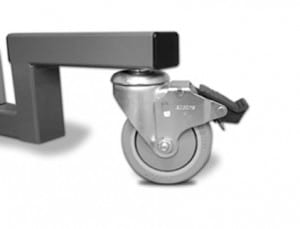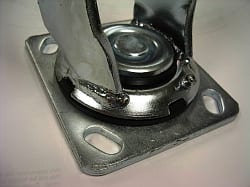 For most business owners, new caster wheels are a significant investment that should be able to last a pretty long amount of time. Even so, the best caster wheels require a good amount of maintenance in order to maintain their functionality for the long haul. By carefully cleaning and maintaining caster wheels, commercial business owners and others will be sure to get the best return on their investment, ensuring that replacement wheels don’t need to be bought for at least several years. For those who are unfamiliar with how to properly maintain these essential pieces of hardware, there are generally three things to keep in mind.
For most business owners, new caster wheels are a significant investment that should be able to last a pretty long amount of time. Even so, the best caster wheels require a good amount of maintenance in order to maintain their functionality for the long haul. By carefully cleaning and maintaining caster wheels, commercial business owners and others will be sure to get the best return on their investment, ensuring that replacement wheels don’t need to be bought for at least several years. For those who are unfamiliar with how to properly maintain these essential pieces of hardware, there are generally three things to keep in mind.
First, Make Sure that the Caster Wheels are Properly Lubricated
Lubrication is essential when ensuring that casters last as long as possible. In most cases, this means that caster wheels and their fittings should be lubricated roughly every six months. It’s a good guideline to follow, and it should be a scheduled time when all of a business’ casters and other hardware are inspected, lubricated, and ensured to work properly.
It should be noted, however, that the six month timeframe is not a universal recommendation. The nature of many types of casters means that they’re often used in volatile environments where they frequently get wet. Still other casters are exposed to highly corrosive materials on a regular basis. In both of these cases, casters should be checked and lubricated on a far more frequent basis. When exposed to moisture and corrosive materials regularly, casters should be lubricated at least once each month to ensure their integrity.
Next, Check the Fasteners that Hold the Casters in Place
Just as important as the caster’s lubrication are the hardware fittings that ensure the wheel doesn’t move — or fall off entirely. These essential pieces of hardware are prone to regular wear and tear, especially because they’re working against the forces of gravity on a near daily basis in most environments.
Once a month, every piece of equipment that has casters attached to it should be turned on its side. Then, business owners should begin inspecting the hardware that fastens the caster to the equipment itself. That means looking for nuts,  bolts, screws, and any other fittings that keep the wheel in place. If anything is bent, worn, or out of place, it should be fixed or replaced immediately. These minor defects can slowly ruin a caster and force its replacement over time in some situations, making it essential that they’re fixed earlier, rather than later.
bolts, screws, and any other fittings that keep the wheel in place. If anything is bent, worn, or out of place, it should be fixed or replaced immediately. These minor defects can slowly ruin a caster and force its replacement over time in some situations, making it essential that they’re fixed earlier, rather than later.
Finally, Examine the Caster Wheel Itself and Make Any Necessary Repairs
Lubrication and fastenings are both important, but so is the integrity of the caster wheel itself. In most cases, casters come with a small treat or rubber fitting that allows them to make cleaner turns with less overall noise. these treads can sometimes flatten or might be slightly damaged by the floor on which they’re rolling. Such defects can, over time, place unnecessary wear and tear on the caster wheel itself; these defects can even ruin the hardware and lubrication fixes made in earlier steps of the maintenance process.
Regularly check a caster wheel’s treads and construction for damage. If necessary, replace a damaged wheel or tread before it becomes a larger problem that necessitates the replacement of the entire caster itself. A monthly inspection routine is probably a good idea for most business owners when ensuring the long-term integrity of the caster.
Attention to Detail is a Great Maintenance Strategy
Regular, detail-oriented inspection of casters is the best way to keep them in good repair and ensure that they live out their entire rated lives after purchase. With the right lubrication, inspection, and repair, they’ll last for many years without requiring expensive replacement and installation.
Contact us for more information on caster wheels today.




